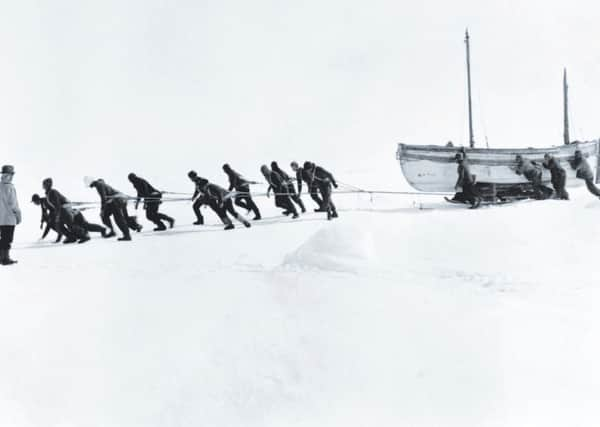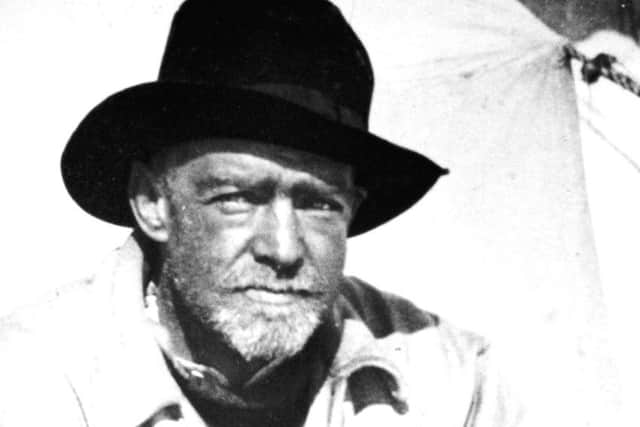Ernest Shackleton and an epic tale of bravery and endurance a century on


ON April 24, 1916, a small lifeboat set out on a near-impossible 800-mile journey across the world’s most treacherous seas in the heart of winter.
On board were six members of an Antarctic expedition led by the famed polar explorer Ernest Shackleton. The men clambered on to the 23ft James Caird and embarked on a hazardous voyage to fetch help for 22 shipmates marooned by ice off the tip of Antarctica.
Advertisement
Hide AdAdvertisement
Hide AdThe ensuing story of endurance and bravery has inspired subsequent generations and is recounted in Harding McGregor Dunnett’s acclaimed book Shackleton’s Boat – The Story Of The James Caird.


Dunnett died in 2000 and the book, which first came out 20 years ago, is being republished to mark the centenary of this astonishing journey.
Ernest Shackleton was a hugely charismatic man who lived life “like a mighty rushing wind”. In 1914, the adventurer, whose family came from Yorkshire, made his third trip to the Antarctic with the ship Endurance, planning to cross the continent via the South Pole.
The story of the expedition, its trials and tribulations and Shackleton’s leadership in the face of almost certain death, have since become the stuff of legend.
Advertisement
Hide AdAdvertisement
Hide AdEarly in 1915, the ship became trapped in the ice and 10 months later sank. Shackleton’s crew had already abandoned the ship to live on the floating ice. In April 1916, they reached Elephant Island, off the coast of Antarctica.


It was at this point, with their supplies dwindling and the weather worsening, that Shackleton along with five hand-picked men set off on their desperate rescue mission.
Harding’s son, Roderick Dunnett, who helps run the James Caird Society, says when they left Elephant Island the situation was grim.
“They were in a precarious position and they needed to get help so six of them, which was as many men as they could fit on board, embarked on an 800-mile journey to South Georgia which was the nearest civilization.”
Advertisement
Hide AdAdvertisement
Hide AdTheir three week journey was a descent into a nautical maelstrom that pushed them to the limits of human endurance.
“They were in this small boat and it was right in the middle of winter. The minute they were out in open water they had to contend with horrendous conditions. Shackleton later refers to 90 foot waves which should have turned the boat over, but somehow they managed to ride the water,” says Dunnett.
It was not only mountainous waves that the men had to contend with. “The boat was totally covered in ice which had to be chipped off. But even heavily gloved this was a nightmarish task because they were clinging on to the boat at the same time. There was also a dangerous amount of water getting in which they had to bale out for hours on end.”
Dunnett says it was a miracle they survived and reached dry land. “South Georgia is a speck in the ocean and if they had missed it and gone round the northern end they would have headed towards Africa and never made it.”
Advertisement
Hide AdAdvertisement
Hide AdBut despite having reached the island just about in one piece there were plenty more obstacles that lay ahead.
They had landed on the opposite side of the island to the whaling stations at Stromness and with Shackleton having ruled against trying to make the 150-mile journey by sea, the men had to trek across the island, which meant tackling an unmapped wilderness of snowfields and glaciers.
Two of the men were too ill to travel so Shackleton, along with his colleagues Frank Worsley and Tom Crean, made the gruelling 10-day journey. “They eventually reached the whaling station and the next day there was a snow storm and had they been caught up in that they wouldn’t have made it,” says Dunnett.
Having reached civilisation they knew they were in a race against time to rescue their shipmates stranded on Elephant Island.
Advertisement
Hide AdAdvertisement
Hide AdThe challenge now was to try and return to Antarctica as soon as possible. The first attempt was on a local whaling ship but the pack ice barred their path 70 miles from Elephant Island and they were forced to head to the Falkland Islands.
The explorer contacted the Uruguayan authorities who sent a trawler but this, too, was unable to get through. In July, in desperation, he chartered a wooden schooner but once again the ring of ice forced him to abandon the attempt to rescue his stranded men.
Finally Shackleton was loaned the steam tug Yelcho by the Chilean government and on August 30, at the fourth attempt, they reached the 22 men who were alive but exhausted and near starvation. The rescued men were then taken back to Chile amid huge public celebrations.
The man Shackleton had left in charge on Elephant Island was a Yorkshireman called Frank Wild. Having been on four Antarctic expeditions the Skelton-born explorer was the obvious choice to take charge in Shackleton’s absence.
Advertisement
Hide AdAdvertisement
Hide Ad“Wild is one of the heroes of this story,” says Dunnett. “He had an optimistic disposition and told the men, ‘pack up lads, the boss may come today’ and of course the boss did finally come.”
The story of the epic ocean crossing in a small whaling boat, the ensuing trek across South Georgia and the eventual rescue of the remaining men from the Endurance who had been left behind, is arguably Shackleton’s finest hour.
It is rightly regarded as one of the greatest rescues in history and it’s one that Dunnett believes highlights Shackleton’s leadership traits.
“If you wanted scientific expertise then (Robert) Scott was the man. If you wanted to speed across the terrain then (Roald) Amundsen was the man.
Advertisement
Hide AdAdvertisement
Hide Ad“But if you found yourself in a big hole then get on your knees and pray for Shackleton, because he was the man to get you out of it.”
In the end it was his health, rather than his luck, that gave out, and it was during his fourth Antarctic trip in 1922 that Shackleton suffered a heart attack in Buenos Aires and later died on South Georgia.
Today, a century on from one of his crowning glories, Shackleton is widely regarded as one of the greatest explorers of the 20th Century, and is also a man whose leadership qualities and techniques are still taught to would-be business leaders.
As for the James Caird, it still survives.The boat was restored in the 1960s and went on display at the National Maritime Museum in Greenwich and today is housed at Shackleton’s former school Dulwich College.
Advertisement
Hide AdAdvertisement
Hide Ad“It’s a living symbol of the most desperate rescue attempt ever undertaken. The South Atlantic in winter has the worst seas in the world and this little boat and those on board stood up to everything that was thrown at the them and they made it,” says Dunnett.
“History is full of stories about great deeds of bravery and courage and here is a classic boy’s own story from a hundred years ago that is almost within living memory. I think as long as people talk about great feats of heroism they will talk about Shackleton and the James Caird.”
Shackleton’s Boat – The Story of the James Caird, published by The Collins Press, is out now priced £10.99
Explorer’s true Yorkshire grit
Ernest Shackleton’s family links with Yorkshire run deep.
The Shackletons came from Yorkshire, taking their name from the village of Shackleton, near Heptonstall in West Yorkshire.
Advertisement
Hide AdAdvertisement
Hide AdStarting in the 1590s the explorer’s ancestors lived at Shackleton House in Bingley until one of his relatives, Abraham Shackleton, moved his family to southern Ireland.
Ernest Shackleton made his name as a charismatic explorer. He was famed for his leadership and bravery during his South Pole expeditions.
His fourth expedition aimed to circumnavigate the Antarctic continent but on January 5, 1922, Shackleton died of a heart attack off South Georgia. He was buried on the island.